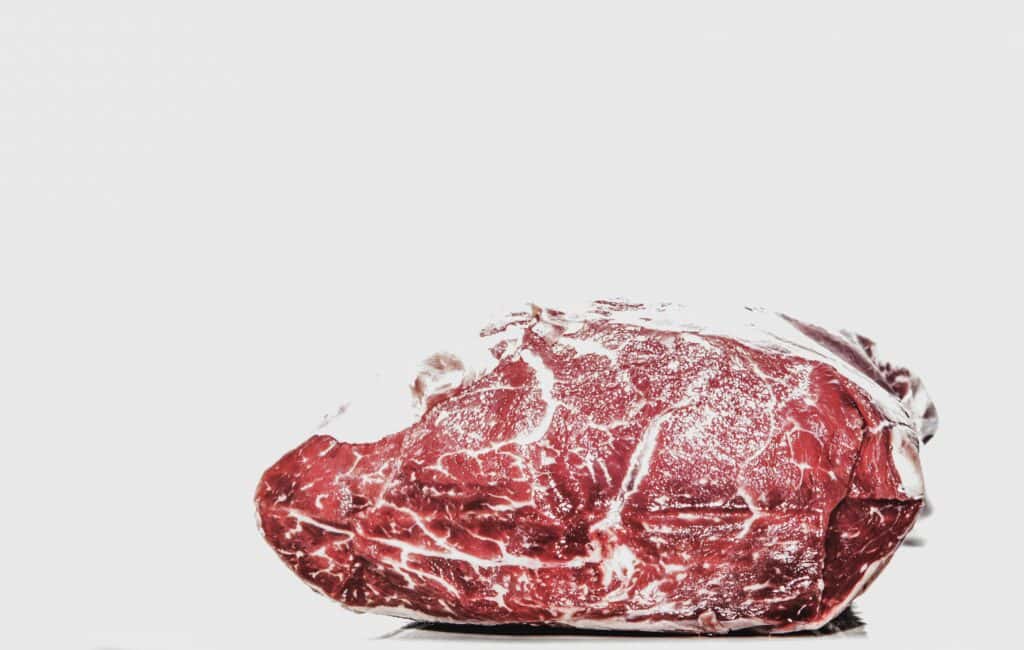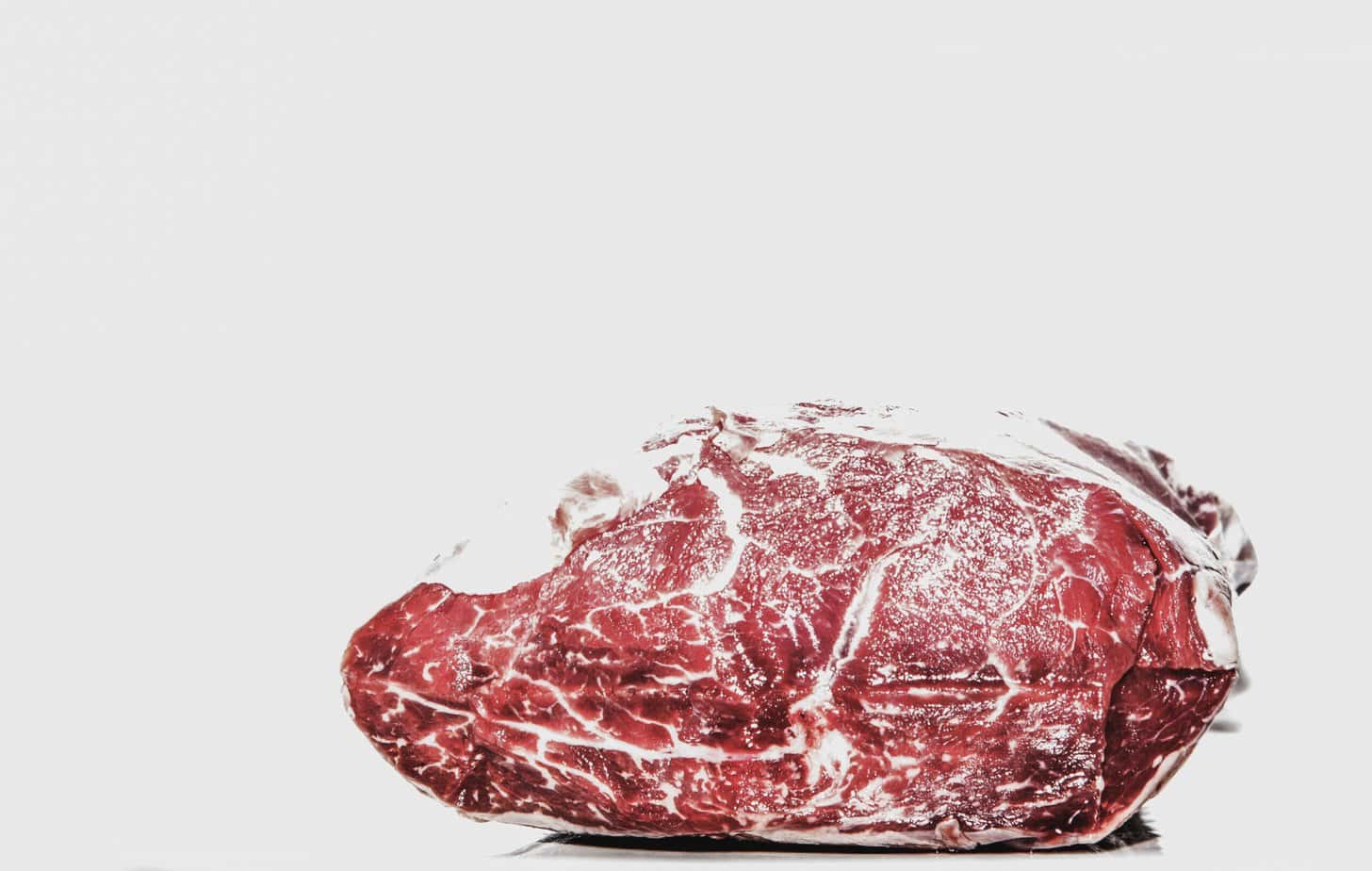How to Defrost Beef? The best way to defrost beef is in the refrigerator, as it ensures safe and even thawing while preserving the beef’s quality. Place the beef on a plate or in a shallow dish, keep it sealed, and allow 24 hours of defrosting time for every 5 pounds of beef.
When it comes to preparing beef for a meal, one crucial step that often gets overlooked is the defrosting process. Properly thawing beef not only ensures safety and maintains quality but also impacts the taste and texture of your final dish. With that in mind, let’s see the best practices on how to defrost beef.

But we don’t stop at the basics. We delve into advanced topics, including defrosting beef stew and understanding the critical issue of how long beef takes to safely thaw at room temperature.
Why Proper Thawing of Beef Matters
Defrosting beef correctly is vital for several reasons. Firstly, it ensures even cooking; frozen spots in meat can lead to uneven cooking, with some parts overdone while others remain raw. Secondly, rapid temperature changes can cause bacterial growth, posing health risks. Lastly, the right thawing method can preserve the beef’s flavor and tenderness, making your meal more enjoyable.
In this article, we explore the science of on how to defrost beef. Understanding why proper defrosting matters for food safety, taste, and texture is crucial. We provide step-by-step instructions, insider tips, and best practices for each method, ensuring you achieve perfect results consistently.
We cover quick defrosting, microwaving, water immersion, fridge defrosting, and oven techniques. We also clarify misconceptions about room temperature thawing.
How to Defrost Beef Safely in the Refrigerator
Step-by-Step Guide:
- Plan Ahead: Begin thawing your beef in the refrigerator at least 24 hours before you plan to cook it. Larger cuts, such as roasts, may require up to 48 hours.
- Packaging: Keep the beef in its original packaging or place it in a shallow dish to catch any drips and prevent cross-contamination.
- Temperature: Ensure your refrigerator is set at a safe temperature, below 40°F (4°C), to keep the beef at a safe temperature throughout the thawing process.
Benefits:
- This method is the safest as it keeps beef at a consistent, safe temperature, reducing the risk of bacterial growth.
- A unique advantage of refrigerator defrosting is the opportunity to marinate the beef during the thawing process. As the beef gradually thaws, it can absorb the flavors of your marinade, enhancing the taste of your final dish.
- It preserves the meat’s texture and flavor.
One of the critical factors in food safety is avoiding the temperature danger zone, where bacteria thrive. Refrigerator defrosting keeps the beef within safe temperature limits throughout the thawing process. This minimizes the risk of foodborne illnesses. (Source)
Here is an indepth article on how to defrost in fridge.
Quick & Safe Method to Defrost Beef Using Cold Water
Step-by-Step Guide:
- Seal: Place the beef in a leak-proof plastic bag to prevent water from getting in and to avoid bacterial contamination.
- Submerge: Fill a large bowl with cold water and submerge the bagged beef.
- Change Water: Change the water every 30 minutes to ensure it remains cold, speeding up the thawing process without raising the meat’s temperature to a dangerous level.
Duration: This method can take approximately 1 hour per pound of beef.
Benefits:
- Faster than refrigerator thawing, making it ideal when you’re short on time.
- It minimizes bacterial growth by keeping the beef at a cool temperature.
- The time required for cold water defrosting depends on the beef’s size and thickness. As a general guideline, allow 25 minutes of defrosting time per pound (0.46 kg) of beef. This method is quicker. it’s an excellent option if you need to thaw beef within a few hours. (Source)
Fastest Way to Thaw Beef: Microwave Thawing Technique
Defrosting beef in the microwave is undoubtedly the fastest method, but it requires caution to avoid compromising the beef’s quality.
Step-by-Step Guide:
- Remove Packaging: Take the beef out of its packaging to avoid any chemical leach into the meat.
- Use Microwave Defrost Setting: Place the beef on a microwave-safe plate and use the defrost setting based on the weight of the beef.
- Cook Immediately: Since the microwave can partially cook the beef, it should be cooked immediately after thawing to prevent any bacterial growth.
Benefits:
- The quickest method, suitable for when you’re in a hurry.
- Useful for small cuts or ground beef.
Comparison of various beef defrosting methods
Below are the comparsion of various beef defrosting methods
| Aspect | Refrigerator Defrosting | Cold Water Defrosting | Microwave Defrosting |
|---|---|---|---|
| Speed | Slow: Requires 24 hours for every 5 pounds of beef | Moderate: 30 minutes per pound | Fast: Varies by microwave settings |
| Temperature Control | Maintains a Safe Temperature (40°F or below) | Requires Regular Water Changes to Stay Cold | Utilizes Microwave Settings for Thawing |
| Food Safety | High: Minimal Risk of Bacterial Growth | Moderate: Requires Monitoring | Requires Care to Prevent Partial Cooking |
| Flavor and Texture Preservation | Excellent: Gradual Thaw Preserves Quality | Good: Maintains Quality but May Lose Some Flavor | Requires Monitoring for Texture Preservation |
| Risk of Partial Cooking | Low: Unlikely to Cook Meat | Low | High: Potential for Partial Cooking |
| Flexibility (Marination) | Yes: Opportunity to Marinate While Thawing | Yes | Limited: Marination is Possible with Care |
| Suitable for Larger Cuts | Yes: Suitable for Large Beef Cuts | Yes: Suitable for Medium sized Beef Cuts | No: Not Recommended for Larger Cuts |
| Suitable for Beef Stew (Flavor) | Excellent: Preserves Stew’s Flavor | Good: Maintains Stew Quality but Flavor May Be Affected | Requires Skill for Flavor Preservation |
| Convenience | Requires Advanced Planning | Moderate: Requires Time and Attention | Quick: Requires Close Monitoring and Care |
What to Avoid While Defrosting Beef
- Avoid Hot Water: Thawing beef in hot water can cause the outer layer to enter the danger zone (between 40°F and 140°F), where bacteria can multiply rapidly.
- Avoid Room Temperature: Leaving beef out on the counter can lead to unsafe temperature variations, increasing the risk of foodborne illness.
Preparation Tips Post-Thawing of Beef
After your beef is thawed, it’s important to:
- Dry It Off: Pat the beef dry with paper towels to remove excess moisture. This helps achieve a better sear if you’re grilling or pan-frying.
- Rest: Allow the beef to come to room temperature for a more even cook. This should take no more than 20 minutes to ensure safety.
Defrosting technique for different beef cuts
- Large Roasts: Due to their size, it’s safest to plan ahead and use the refrigerator method to ensure even thawing without any parts of the meat getting too warm.
- Ground Beef: If using the microwave method, break apart the beef and rotate it frequently for even thawing. Cooking it immediately after thawing is crucial.
- Steaks: For quicker thawing while retaining moisture, consider sealing steaks in a vacuum-sealed bag before submerging in cold water. This can reduce thawing time and improve texture.
Common Mistakes and Solutions for Thawing Frozen Beef
Here’s a table outlining common mistakes when thawing frozen beef and their respective solutions:
| Common Mistakes | Solutions |
|---|---|
| Thawing beef at room temperature | Thaw in the refrigerator, use cold water thawing, or microwave defrosting to keep beef out of the “danger zone”. |
| Not changing water during cold water thawing | Change the water every 30 minutes to ensure it stays cold and safe. |
| Leaving beef in the microwave too long | Use the defrost setting and check frequently. Cook immediately after to prevent partial cooking. |
| Refreezing beef thawed at room temperature | Only refreeze beef thawed in the refrigerator and not left out for more than 2 hours. |
| Cooking partially frozen beef without adjusting time | Increase cooking time by about 50% for beef that’s not fully thawed. |
| Using hot water to speed up thawing | Always use cold water to prevent bacteria growth. Hot water can bring beef into the danger zone. |
| Not planning ahead for refrigerator thawing | Allow enough time for thawing in the fridge: 5 hours per pound for roasts, 12-24 hours for smaller cuts. |
| Forgetting to place beef in a leak-proof bag during cold water thawing | Ensure beef is in a leak-proof bag to prevent water absorption and contamination. |
By avoiding these common mistakes and following the recommended solutions, you can ensure your beef is thawed safely and retains its quality.
Here is a quick guide on how to defrost fish and how to defrost chicken and how to defrost turkey.
Frequently Asked Questions on How To Defrost Beef
Is it safe to defrost beef at room temperature?
Defrosting beef at room temperature is not safe as it can enter the “danger zone” (40°F-140°F), where bacteria grow rapidly. Always defrost beef in the refrigerator, cold water, or microwave to ensure safety.
How do you know when beef is fully defrosted?
Beef is fully defrosted when it’s pliable and no ice crystals remain. For thicker cuts, check the thickest part by gently pressing or inserting a skewer to ensure it’s thawed throughout.
Can you refreeze beef after defrosting?
You can refreeze beef after defrosting if it was thawed in the refrigerator and hasn’t been outside the fridge for more than 2 hours. Quality may diminish due to moisture loss, so it’s best used in cooked dishes.
Does defrosting beef in the microwave affect its quality?
Defrosting beef in the microwave can slightly affect its quality, leading to uneven thawing and potentially cooking some parts of the meat. It’s best for small cuts or ground beef that will be cooked immediately after thawing.
How long can defrosted beef stay in the refrigerator before it needs to be cooked?
Defrosted beef can stay in the refrigerator for 1-2 days before it needs to be cooked. Ground beef should be cooked within 1 day, while steaks and roasts have a 2-day window. After this period, quality and safety can decline.
How Long Does Beef Take to Thaw at Room Temperature?
The time it takes for beef to thaw at room temperature varies based on factors like beef size and room temperature. Small cuts may thaw in a few hours, while larger cuts can take several hours or more.
This is your answer on how to defrost beef. Here are some good places to learn more about defrosting beef. (Source)




